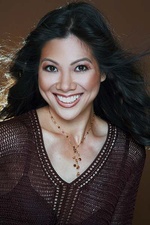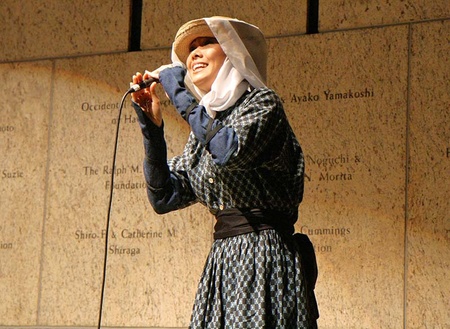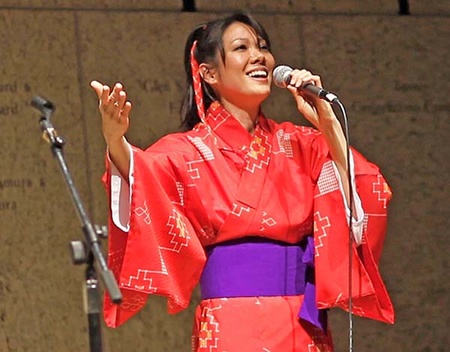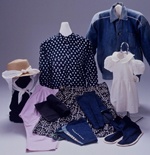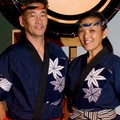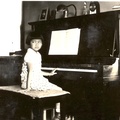INTRODUCTION
On February 27, 2010, the Japanese American National Museum opened its exhibition Textured Lives: Japanese Immigrant Clothing from the Plantations of Hawai’i, which featured the extraordinary research of Barbara Kawakami. As part of the opening celebration, the Museum invited singer Allison Arakawa to perform an example of Hole Hole Bushi, a Japanese American folk song form that developed directly from the plantation experiences of the Issei.
Hole Hole Bushi is a hybrid term that combines the Japanese word for tune (bushi) with a Hawaiian term describing the stripping the leaves off of cut sugar cane (hole hole), which was primarily women’s work. Issei women composed and sung a repertoire of these songs, set to familiar Japanese melodies, which expressed their hardships, disappointments, and hopes.1
In this interview, Allison Arakawa discusses her performance at the exhibition opening, her admiration of Kawakami’s work, and her own relationship to cultural tradition and history in Hawai`i.
Q & A WITH ALLISON ARAKAWA
- How long has your family been in Hawai`i?
I was born and raised in Honolulu, Hawai`i and am fourth generation on both sides of my family. My mother is of Chinese descent and my father is Okinawan. Like most, my great-grandparents made their way to Hawai`i for work and in search of a better life. My great-grandfather on my mother’s side was a tailor, while my great-grandfather on my father’s side came to work on the plantation.
- Describe what you did at the opening event.
Before the opening, Barbara Kawakami called and asked me to sing [Hole Hole Bushi], which is the Issei plantation song that was born in the sugar cane fields through their hardships. The premise of the song is similar to African American work songs in that were made up while they toiled in the fields. The songs expressed the Issei’s experiences: longing for home and the dilemma found in their new life in Hawai`i. When I perform this, I wear a costume that was made for me by Barbara when I was a teenager. It’s made from hand-woven cotton fabric, or kasuri, that was brought to Hawai`i from Hiroshima by Mrs. Sagami Shinozawa. Mrs. Shinozawa came to Hawai`i as a picture bride and had given the unused bolt of fabric to Barbara for her research.
- How and when did you begin studying Japanese music?
I enjoyed music and liked to sing at an early age. I told mother that I wanted to sing and expected to learn English-language music; however, at the encouragement of my grandmother, my parents put me in Japanese music lessons. At the age of four, I began studying music under Harry Urata, who had also taught my aunt when she was young. I suppose music runs in my family a little bit: when I was growing up, my dad played guitar as a hobby. One of my aunts also sang, and I have an uncle who is a pianist.
At first, I learned Japanese children’s songs, or doyo. Lessons were fun. Sensei would always use stories to explain the songs, so it was like story time. We would get a little bit of Japanese culture and history along with the songs. As I got older, the songs transitioned into enka. By that time, I was used to singing in Japanese. I didn’t necessarily understand what I was literally singing word for word—but I understood the meaning and the feeling behind the songs. Singing in Japanese was “normal” for me even though it was not my native language.
- Who is Harry Urata?
Urata Sensei was a Kibei, a Hawai`i-born, Japan-educated Nisei. He was a music teacher and an orchestra leader in the big band era. During World War II, he was sent to an internment camp and that’s where he was encouraged to collect the plantation songs of the Issei. Years after the war, he visited Issei on the different islands, and collected their versions. There were varying melodies of the Hole Hole Bushi throughout the camps, so Urata Sensei created a standardized version that could be learned and preserved. He selected verses that painted a good picture of the Issei experience and we recorded them. There isn’t any one definite or correct version since there are many verses that exist, even naughty and risqué ones, too. (laughs) Fortunately, Sensei was able to document the stories and learn from of the Issei before that first generation was gone.
- When did you start learning Hole Hole Bushi?
I was in my teens—probably about 14, maybe a little older. Urata Sensei told me, “Here, I want you to sing this song.” And he explained the significance of the song—that it is the story of the Issei and their struggles to make a new life for their families in a foreign land. He introduced me to Barbara Kawakami, who made me a costume, and from then on, I became the Hole Hole Bushi girl. I was just about the same age that most picture brides were—the Issei women came to Hawai`i at a really young age, around 17 years old or younger.
The Hole Hole Bushi became more well-known and his students would go out and do community events singing that song.
- And describe the costume that Barbara Kawakami made for you—what was your initial reaction to it? How do you relate to it now?
Oh my god, I have to wear that?! (laughs) I knew that it was a cultural piece and quite fashionable for that time with respect to the hard labor that went along with it, but by modern standards, not quite so much. It is comprised of many pieces including tabi, a big straw hat, a bandana around the face/head and one on top of the hat. Tesashi (hand/arm protectors), kyahan (leg protectors), a long sleeve button front top, a skirt, and an obi (sash) completes the outfit. People can’t really see my face when I’m wearing it and are often surprised that under the hat, I’m younger than they had thought.
Barbara is such a nice lady, and she has accomplished so much. When Sensei asked her to make the costume for me, it happened to be a very busy time in her life. She was in the midst of working on her first book, but she still agreed to make it for me. I remember going to her house where she measured me and made adjustments. And, you know, 20 years later, I’m still wearing the same costume. It was a lot looser then, of course, but miraculously it still fits. I cannot gain any more weight at this point or I’ll be in trouble!
But really, I think of it as very special because the fabric that Barbara used was from a picture bride. This material is probably close to 100 years old! I have been wearing it for so long, it feels like one of my costumes now. I don’t think I have ever sung the Hole Hole Bushi in any other attire. When I performed at the opening of Textured Lives, I changed before I sang my second song. Since I am fortunate to have the outfit, I think it’s important to keep the integrity of the Hole Hole Bushi, respecting the spirit of the song.
>> Watch her Hole Hole Bushi performance at the opening of Textured Lives
- Explain what you consider significant about Hole Hole Bushi.
It is the story of the Issei and their struggles to make a new life for their families in a foreign land. The songs tell of their sacrifices that made it possible for what we have today. Also, the holehole work played an important role in the development of Hawaii’s sugar cane industry, and added to the cultural mix found in the islands.
The version that Urata Sensei had me record for the CD in 2000 has four verses. And all the verses are really poignant, but the third one in particular is very poetic—it’s my favorite. The imagery is simple but conveys much. It goes:
It’s starting to rain,
The wash is getting wet,
The child is crying upon the mother’s back,
And the rice just burnt
There’s also another adaptation of the song, the Ozashiki version. This was performed in the teahouses, where the people would go to relax and be entertained. This version is faster and has a shamisen accompaniment. It’s a more lively, party-atmosphere kind of song. I mainly sing the plantation version though. The CD we recorded actually includes the karaoke for both versions.
- How do audiences respond when you sing this?
People are moved by the hardship of the Issei and are touched by their stories. When I’ve sung it in Japan and Hawai`i, the audience usually goes quiet. I’m glad that the song commands attention. I have seen people get teary eyed. Especially in Japan—I think a lot of Japanese may have relatives and friends who left for Hawai`i decades ago. And they don’t know what happened to them or to the others who they knew who emigrated. So, it’s very moving for them to hear something about their experiences through this song.
- Changing topics a bit—tell me about the other song that you sang at the Textured Lives opening.
“Bashofu” talks about Okinawa, “my homeland.” It is a song that was written by the famous Okinawan composer Tsuneo Fukuhara, who wrote the song for my Aunt, Clara Arakawa, to sing. “Bashofu” became quite well known in Okinawa, Japan, and Hawai`i, especially among those with Okinawa ties. In 1994, I received a government scholarship to study Japanese in Okinawa. There I learned koten, classical Okinawan music, as well as minyo. I was fortunate to study under Tsuneo Fukuhara Sensei and Chieko Iha. I also learned a little sanshin (Okinawan shamisen) under Terukina Choichi Sensei. I have been singing “Bashofu” as far as I can remember. My dad used to make my sister and I sing it when he played the guitar. Learning to sing Okinawan minyo was an amazing experience. The Okinawan style of singing, I found, was the complete opposite of enka. Whereas enka has a lot of vibrato, Okinawan music does not, rather more high and lows. I had to learn to sing in Okinawan hogen (dialect), which was a challenging, but fun.
>> Watch her singing an Okinawan classical song at the opening of Textured Lives
- What else has been a part of your musical training?
In addition to the Japanese and Okinawan music, I also took piano lessons for several years. I played percussion in intermediate school and since then have attempted to learn the guitar.
- You’ve been very involved in expressing your Okinawan cultural heritage. How about your Chinese side?
Unfortunately I did not end up doing Chinese cultural activities per se but we did celebrate the main holidays, though mainly through food! My Chinese grandmother made sure we had treats like gau and candied coconut during Chinese New Year in addition to the typical Chinese menu year-round. My father was insistent that my sister and I take martial arts so we took aikido for a few years and then got enrolled in Okinawan-style goju ryu karate. China had such great influence on Okinawa that it is ingrained in their history and culture. This has always helped me feel very connected, but I look forward to exploring my Chinese culture more in the future.
- So when did you come to the mainland?
2002
- And what sort of work are you doing in Los Angeles now?
I work in licensing at Disney Consumer Products.
- And music—it has clearly been a major current in your life. What is it like for you now?
Music will always be a part of my life. Growing up, I entered many contests and performed a lot in the community. The venues are different now than they were when I was a kid in Hawaii. I still sing at cultural events here in California and Hawai`i when asked, but I’ve also had great opportunities to sing at events in Japan and Okinawa. And then of course, I sing for fun at home with my husband, who is a great guitar player.
- How has the meaning of Hole Hole Bushi and how you sing it changed since when you first learned it?
I hope that I get better as I age. Life brings experiences that change your perspective as you grow. It has given me a deeper appreciation for many things and I hope this translates through my music.
I’m so glad Urata Sensei and Barbara Kawakami had the foresight to preserve the culture and history of the Issei. If they hadn’t collected and documented these things, we would not have them today and a part of our heritage would likely have been lost forever.
I am grateful to be a part of it and know that I have been extremely fortunate that Sensei included me in his life’s work. He taught me the song and allowed me to record it. I want to continue to do it as long as I can. It’s our history. And I’m honored to have the opportunity and be able to share it.
Note:
1. For more on Hole Hole Bushi, see:
- Franklin S. Odo and Harry Minoru Urata, “Hole, Hole, Bushi: Songs of Hawaii’s Japanese Immigrants in Hawaii,” in Hawaii Mana (Hawai`i: Elepaio, 1981).
- Susan Asai and Fred Ho, “Hole Hole Bushi: Cultural/Musical Resistance by Japanese Women Plantation Workers in Early Twentieth-Century Hawaii,” in Wicked Theory, Naked Practice: A Fred Ho Reader, edited by Diane C. Fujino (Minneapolis: University of Minnesota Press, 2009).
* * *
Textured Lives: Japanese Immigrant Clothing from the Plantations of Hawai`i
February 28 - August 22, 2010
The experiences of early Issei in Hawai`i are revealed and illuminated through exquisite examples of kimono adapted for life and labor on Hawai`i’s plantations. The exhibition will interweave these priceless textiles from the National Museum’s Permanent Collection with rare oral histories and moving images, photographs, and expert video commentary by scholar Barbara Kawakami.
For more information about the exhibition, visit: janm.org/exhibits/texturedlives
© 2010 Sojin Kim


